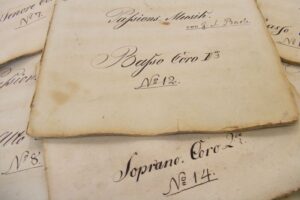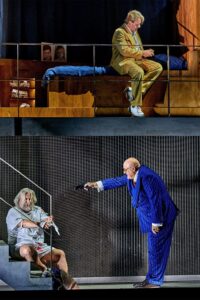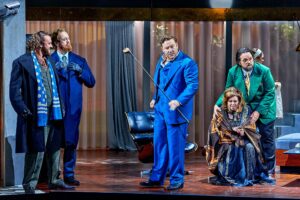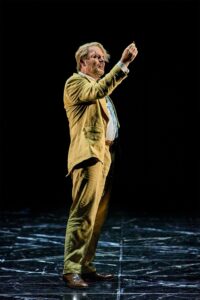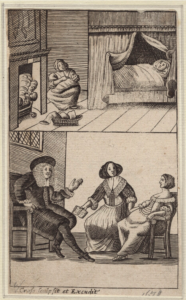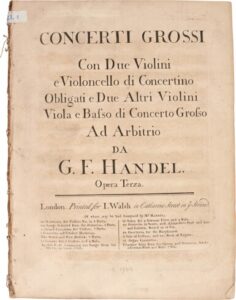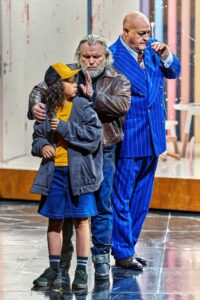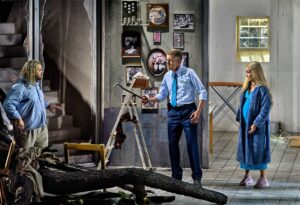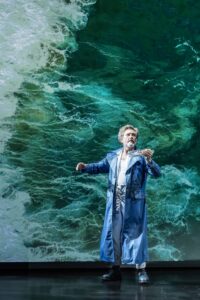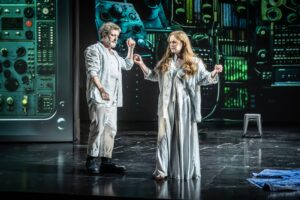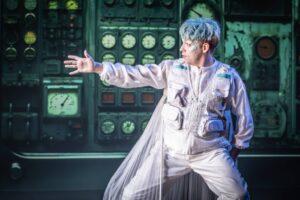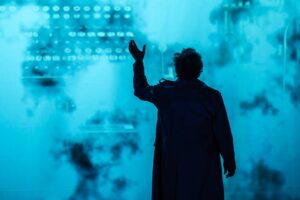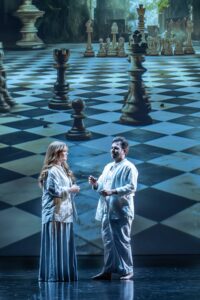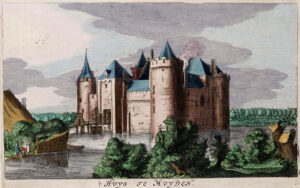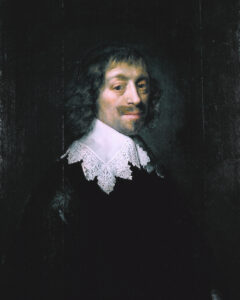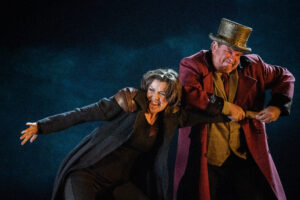O pożytkach z praktyk robotniczych
W tym miejscu powinna już dziś znaleźć się relacja z kilku ostatnich dni Innsbrucker Festwochen der Alten Musik – ale się nie znajdzie, bo podobnie jak wszyscy, głowę mam teraz zajętą dramatycznymi doniesieniami z południa Polski. Przerażona skalą zniszczeń w Kłodzku, Nysie i innych miastach Dolnego Śląska, trzymam teraz kciuki za Wrocław, z którym wiąże mnie wiele wspomnień, dobrych i złych, przede wszystkim jednak nieustająca więź z tamtejszym środowiskiem muzycznym. Przeglądając archiwa, natknęłam się na tekst napisany po rozmowie z Hansem-Christophem Rademannem – i nigdy nieopublikowany, między innymi dlatego, że zgodnie z przewidywaniami dyrygenta wrocławskie wykonanie Pasji Mateuszowej w wersji Mendelssohna nie padło wówczas na podatny grunt. Może warto jeszcze kiedyś spróbować. Może już dojrzeliśmy.
***
Początek studiów Hansa-Christopha Rademanna w drezdeńskiej Musikhochschule przypadł na schyłkową fazę Niemieckiej Republiki Demokratycznej. Późnym latem, przed rozpoczęciem roku akademickiego, młodych ludzi kierowano do pracy w państwowych zakładach przemysłowych i gospodarstwach rolnych – celem zbratania przyszłych inteligentów z klasą robotniczą. Rademann trafił wprost na wykopki ziemniaków. Żeby nie zanudzić się na śmierć, wziął ze sobą sporo nut. Próby sekcyjne chóru organizował już za dnia, w ramach grup obsługujących kombajn ziemniaczany. Po pracy w polu studenci spotykali się w pełnym składzie i ćwiczyli do późnej nocy. Takie były początki Dresdner Kammerchor, założonego oficjalnie w 1985 roku i prowadzonego przez Rademanna do dziś.
Chórmistrz wspomina ten czas z dystansem i nieskrywanym rozbawieniem, choć szlaki pionierów wykonawstwa historycznego w Niemczech Wschodnich nie były usłane różami. Na szczęście Rademann wychował się w rodzinie o głęboko zakorzenionych tradycjach muzycznych. Jego ojciec był kantorem chóru St.-Georgen-Kirche w Schwarzenbergu – górskim miasteczku w Rudawach, niedaleko ówczesnej granicy z Czechosłowacją. Przestronne, rzęsiście oświetlone wnętrze XVII-wiecznego kościoła salowego uwrażliwiło chłopca zarówno na kontekst, jak i parametry dźwiękowe muzyki baroku. W wieku dziesięciu lat przeprowadził się do Drezna i zamieszkał w szkole z internatem – jako dumny członek tamtejszego Kreuzchor, zespołu działającego nieprzerwanie od lipca 1300 roku, istnej kuźni talentów, w której pierwsze kroki stawiali między innymi śpiewacy Peter Schreier i René Pape, dyrygent Hartmut Haenchen i kompozytor Udo Zimmermann. Kiedy pakował się na praktyki studenckie po egzaminach wstępnych na wydział dyrygentury i chóralistyki Musikhochschule, nie wyobrażał już sobie życia bez śpiewu i muzyki dawnej.
Hans-Christoph Rademann. Fot. Martin Förster
Na uczelni znalazł potężnych mentorów, między innymi Wolframa Steudego, chórmistrza i muzykologa, wybitnego znawcę twórczości Heinricha Schütza. Steude był także współzałożycielem i realizatorem organowego continuo w zespole Cappella Sagittariana – pierwszej drezdeńskiej orkiestry barokowej, działającej od lat 70. ubiegłego wieku pod auspicjami Staatskapelle Dresden. Dzięki połączonym wysiłkom młodego Rademanna, Dresdner Kammerchor i muzyków Cappelli stolica Saksonii stała się wkrótce matecznikiem ruchu wykonawstwa historycznego we wschodniej części Niemiec. Drezdeńscy melomani do dziś wspominają koncerty z Mesjaszem Händla i Weihnachtsoratorium Bacha – ten ostatni z udziałem nieznanego jeszcze kontratenora Andreasa Scholla. Rademann wypomina mu wprawdzie słabość do wyścigów Formuły 1, a co za tym idzie, niechęć do uczestniczenia w próbach przypadających na czas transmisji, nie kryje jednak dumy, że odkrył talent młodego śpiewaka przed jego oszałamiającą karierą w Belgii i Francji.
Szef Kammerchor nie poprzestał na studiach w Dreźnie. Kontynuował edukację pod kierunkiem największych luminarzy wykonawstwa historycznego, przede wszystkim Helmutha Rillinga, założyciela Bach-Collegium oraz Internationale Bachakademie Stuttgart, a także Philippe’a Herreweghe’a, organizatora gandawskiego zespołu Collegium Vocale, którego interpretacje Rademann od dawna traktował jako główny punkt odniesienia przy rekonstrukcji praktyk wykonawczych w muzyce Bacha. Zapewne dlatego w rozmowie o Pasji Mateuszowej w „romantycznej” wersji Mendelssohna – która 26 lutego 2017 roku zabrzmiała pod jego kierunkiem w NFM – zastrzegał się nieustannie, niepewny, jak przyjmie ją wrocławska publiczność, nawykła już do purystycznych ujęć z udziałem niewielkich chórów i zespołów instrumentów dawnych.
Rademann podkreślił, że w legendzie o Mendelssohnie jako ponownym „odkrywcy” spuścizny Lipskiego Kantora jest wiele przesady. Utwory Bacha nie popadły w zapomnienie, zwłaszcza w Niemczech, gdzie wciąż służyły adeptom kompozycji i kontrapunktu jako źródło inspiracji i materiał do ćwiczeń. Zwrócił jednak uwagę na błyskawicznie zachodzące zmiany w estetyce i wrażliwości doby romantyzmu, a co za tym idzie, ewolucję recepcji twórczości minionego czasu. Mendelssohn musiał dokonać skrótów w Bachowskim arcydziele, przystosować je do możliwości współczesnych odbiorców, oczyścić je z „niemodnych” włoskich naleciałości. Jak twierdzi Rademann, przyszło mu to z tym większą łatwością, że opracowywał kompozycję właściwie nieznaną, spoczywającą w zaciszu bibliotek od końca XVIII wieku, kiedy zabrzmiała po raz ostatni we wnętrzu lipskiego kościoła św. Tomasza.
Głosy chóralne Pasji Mateuszowej w wersji Mendelssohna. Ze zbiorów Bachhaus Eisenach
W pierwszej wersji z 1829 Mendelssohn usunął z Pasji dziesięć arii i siedem chórów. W późniejszej z 1841 roku przywrócił wprawdzie cztery arie i zrezygnował z użycia fortepianu, który zastąpił nietypowym continuo złożonym z dwóch wiolonczel i kontrabasu, wciąż jednak dążył do tego, by przydać dziełu zwartości i dramatyzmu – w romantycznym tego słowa znaczeniu. Zdaniem Rademanna wielu zabiegów Bachowskich po prostu już nie rozumiał. Mendelssohn dokonał skrótów, lekceważąc zakodowaną w dziele symbolikę biblijną, zrezygnował z arii da capo, odzwierciedlających konstrukcję skrzydłowego ołtarza. Bach wyrażał emocje środkami czysto muzycznymi, zgodnie z barokową teorią afektów. Mendelssohn uciekł się do odmalowywania uczuć za pośrednictwem dynamiki, skontrastowanej zwłaszcza w partiach „turbae”, czyli chóru wcielającego się w role tłumu, oraz w recytatywach, które w przeciwieństwie do oryginału niosą w jego ujęciu znacznie potężniejszy ładunek dramatyczny niż arie. Zróżnicował też tempa, w wielu przypadkach wymuszone strukturą dodanych przezeń akordów. Pasja Mateuszowa w wersji Mendelssohna jest fragmentami bardziej rozlewna i solenna, gdzie indziej zaś – burzliwsza w przebiegu niż w partyturze Bacha. Wzbudza zaskakujące nieraz skojarzenia z operą romantyczną.
Jak twierdzi Rademann, wiąże się to również z jej charakterem brzmieniowym. Nieużywane już oboje myśliwskie Mendelssohn zastąpił klarnetem i bassethornem. Zrezygnował z chóru chłopięcego, plasując w jego miejscu cztery dorosłe solistki, podające tekst z dużo większą ekspresją. Przetransponował słynną arię altową „Erbarme dich” na sopran, czyniąc z niej jeden z kulminacyjnych punktów drugiej części utworu. Przewidział w wykonaniu udział potężnego zespołu chórzystów, złożonego nawet ze stu pięćdziesięciu osób.
Rademann chce jednak uniknąć nieporozumień. Podkreśla, że Mendelssohn podszedł do dzieła Bacha z niekwestionowanym pietyzmem – tyle że właściwym dla tamtej epoki. Być może inaczej rozumiał zawartą w nim prawdę: jako prawdę uczuć i emocji, nie zaś autentyzm środków wykonawczych, do jakiego przyzwyczaili nas muzycy związani z nurtem historyzującym. Spytany, czy Pasja Mateuszowa w wersji Mendelssohna ma szansę wejść na stałe do repertuaru koncertowego, zaistnieć w obiegu amatorskim, Rademann kręci głową z powątpiewaniem. Trzeba by ją lepiej oswoić. To nadal jest Bach, ale jakby otulony płaszczem romantyzmu. Wygląda w nim trochę obco. Paradoksalnie, bardziej obco niż ten naznaczony piętnem późnoromantycznej, brahmsowskiej estetyki – jak choćby w nagraniach Otto Klemperera.
Warto zatem odkurzać tę osobliwość? Pewnie, że warto. Zwłaszcza pod kierunkiem człowieka, który oswoił kiedyś pracowników państwowego gospodarstwa rolnego z chóralnym śpiewem studentów. Śpiewem, który na polu ziemniaków musiał brzmieć równie obco, jak zapoznana wersja Mendelssohna w XXI-wiecznej sali koncertowej.


